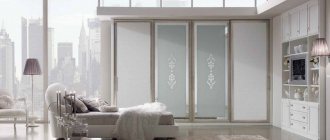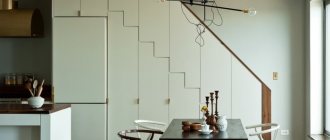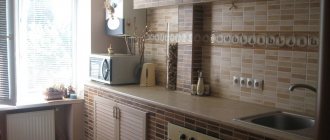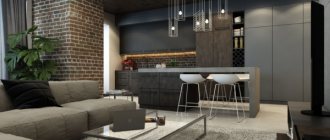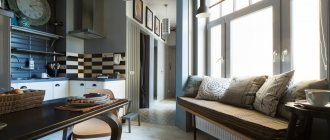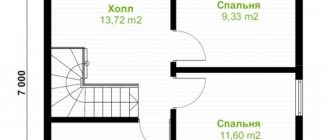A lot changes throughout life, but the desire to look beautiful and highlight one’s social status in a unique way remains unchanged. Clothing helps greatly in solving the problem. At the same time, it is important to monitor not only the style and prestige of the things themselves, but also to ensure their neat appearance, maintain their shape and integrity. These parameters largely depend on the created storage conditions, for example, an equipped separate room or the organization of a dressing room in the bedroom, living room, or pantry.
When building a large mansion, the project can include a special room for storing personal accessories, equip it with good ventilation, a system for maintaining the desired temperature, and general and local lighting. However, for small houses or apartments this approach is practically impossible. But even in cramped conditions, for example, in your own bedroom, you can organize a compact and functional dressing room.
Features of planning a dressing room in the bedroom
Any great undertaking begins with analysis and planning. Arranging a place to store clothes in the bedroom is no exception. First of all, the fact that the room is intended directly for recreation is taken into account. It should be comfortable and cozy, so it is important that the dressing room complements the existing interior. It is unacceptable that it significantly reduces the usable area or interferes with free movement.
When designing, first of all, you should determine the location of the restroom, which directly depends on the layout of the room and its dimensions. One of the simplest options is to re-equip a balcony or loggia, an adjacent storage room, or a niche of the appropriate size. If there are no such structures, then you should pay attention to the ends of the walls and highlight one of the available corners.
The next step in drawing up the project will be to determine the number of users: one person, spouses, the whole family. Ideally, each resident should have their own separate corner, but in small-sized, especially one-room apartments, this is impossible. Next, you should make a list of things to store, sort them, provide separate shelves, drawers, hangers, boxes and baskets for them.
In order to accurately calculate the required area, it is necessary not only to determine the number of things to be stored, but also to provide a small supply, because the wardrobe is constantly replenished.
Walls
A universal solution is wallpaper. You can always choose the appropriate option for a specific stylistic design. If loft is preferred, you can pay attention to decorative plaster. Wooden panels are also often used.
Attention! When choosing wallpaper, you should give preference to waterproof models. They can be easily cleaned of dust.
Types of wardrobe layouts in the room
When arranging a dressing room, you need to think about ensuring that there is no less space in the room, that the bed with a wide headboard remains in easy access, and that the window is not cluttered. It is important not to disturb the geometry of the room and maintain ergonomics. Therefore, the choice of type of layout should be approached very responsibly. Taking into account the dimensions of the bedroom and the availability of free space, you can choose one of the following types:
- open restroom;
- closet;
- linear;
- corner;
- built-in
You will have to think carefully about everything before settling on the most suitable option. You can try to make a competent project yourself. To do this, you need to look through many photos and videos that are easy to find on the Internet. However, it’s not always possible to do everything yourself, even after looking at designer photos, and you can’t do it without the help of professionals. To do this, let’s look in more detail at each of the listed types of arrangement of storage space.
Linear
If the bedroom does not have niches or access to a balcony or loggia, then you will have to allocate space indoors. A linear dressing room can be indispensable for large rooms. It is located along a blank wall with no windows or doors. This type of layout will not disrupt the existing geometry, and if designed correctly, it will fit perfectly into the interior.
Such projects have gained popularity due to their compactness and the ability to create a single style, which makes the design almost invisible. To enclose part of the room space you can use:
- a wall built from plasterboard, various metal structures, glass, which is complemented by sliding, hinged doors;
- a system of sliding doors installed along the entire length;
- cornice with curtains;
- just leave it open.
For comfortable use of the restroom, its depth should be at least 1.5 m. Taking this fact into account, we can conclude that it is not suitable for every restroom. Such a structure cannot be organized in a bedroom that has an elongated rectangular shape, with window and door openings located parallel on the narrow sides. For such premises it is worth considering other options.
Corner
A corner dressing room can be the best solution for both small and spacious rooms. It allows rational use of limited space. It can be placed in a free corner, on the side of a door or window. The design as a whole is universal, but it looks especially good in square or non-standard spaces. It can be open, but for completeness it is better to put a façade.
The main advantages of a dressing room include: large capacity, which allows you to compactly place all your things; space saving, it fills areas that are often not used. Among the main disadvantages are: small dimensions, which makes the process of changing clothes inconvenient; ready-made models are less common on sale compared to other types, which makes them more expensive.
Having chosen such designs, you should understand the existing types. Designers can offer a wide range of original products. They all differ in design and functional features, can have a variety of designs, and are made from various materials. For example, for the loft style, mesh models are suitable; for the high-tech direction, it is better to use wooden pencil cases.
Built-in
A built-in dressing room can be organized in a bedroom where there is a niche, or a closet or pantry is adjacent to it. If there are no such objects, then to organize a restroom you can select a part of the room, separating it from the remaining space with a partition with sliding doors. It is worth considering the fact that for convenient use of this structure, its dimensions must be at least 1.5 m.
A restroom is called built-in if the parts of the wardrobe are walls, floor, ceiling, and the internal space should be sufficient for a person to be inside. There are several types of such structures, which can be divided into the following types:
- Cabinet (rack). Along the perimeter there are ordinary cabinets attached to the walls.
- Panel. When equipping a structure, the walls are sheathed with decorative panels (boiserie), to which shelves, drawers, etc. are attached.
- Modular (frame). Essentially this is a case version. The main difference is in arbitrary modeling, i.e. It is possible to arrange individual elements in any order.
- Loft style. Instead of wooden racks, drawers and shelves, lightweight aluminum structures, metal racks, holders, and mesh baskets are used.
Open
A restroom can be organized in any room of any size. It implies an open method of storing things; there are no fences or doors. It is part of the bedroom itself and fits harmoniously into the interior. A wardrobe of this type still remains unclaimed by many homeowners, due to the inability or lack of opportunity to constantly maintain a neat appearance.
Of course, each person’s needs and preferences are different; some need a lot of space to store things, while others make do with a single closet. And yet, those who decide to arrange an open-type dressing area are faced with a rather difficult task. After all, it is necessary to make the room not only functional, to make the most efficient use of the available space, but also to maintain an attractive appearance.
With proper planning, you can significantly transform a room, complement simple plain walls with cabinets, shelves, racks, drawers and niches. Many manufacturers offer quite creative furniture. Design ideas and a large selection of unique and multifunctional designs will allow you to decorate both spacious apartments and a small bedroom.
Wardrobe
The design can hardly be called a full-fledged dressing room, because it is a wardrobe. However, if you choose a large enough model, it can not only surprise with its functionality, but also harmoniously complement the interior of the room and become its highlight. Such furniture has a depth of about a meter; there are also deeper options, which, in fact, can be used as a small room, even changing clothes inside.
There are many advantages of a wardrobe. Firstly, it has a well-designed interior space; there are separate areas for storing hats, clothes, and compartments for shoes. Secondly, even with large dimensions, it allows you to save space and replaces a lot of other bulky furniture. Thirdly, most models have a mirrored facade, which makes them not only attractive, but also comfortable.
A sliding wardrobe can safely be called intimate furniture, because guests are rarely invited into the bedroom. There will also be no particular problems with choosing such a design. There is a wide variety of different models. You can find both free-standing options and those built into a niche, or installed along a single blank wall. L-shaped and U-shaped types of wardrobes are also available on the market.
How much space is required for a dressing room?
The size of the storage area is of great importance, so it is important to calculate this parameter at the design stage. To correctly set the dimensions for a closet located in the bedroom, it is necessary to determine the type and quantity of clothes stored there, perform zoning, and set the width and length. You should also take into account the area of the room itself, or a separate niche.
The minimum size of the dressing room should be 1.2 x 1.5 m (width, length). But such a design can hardly be called a full-fledged restroom, in which you can not only store things, but also change clothes. If the area of the room allows, then it is worth performing more detailed calculations. The depth indicator depends on the way things are stored and the free space for movement.
If some of the clothes will hang on a rod, then the depth of the closet should be at least 60 cm. If pull-out type end hangers are used, then this parameter is reduced to 35-40 cm. The minimum passage is 60 cm, but for comfortable movement you will need 90 cm, therefore , the optimal depth of the dressing room should be at least 150 cm. The length of the structure will depend on the type of wardrobe layout, the length of the wall, the location of window and door openings.
Corner design
The structure is located in a free corner of the room. Doors are hinged or sliding. This design solution is applicable in rooms of any configuration, square, rectangular, or non-standard geometry. The dressing room, located in the bedroom behind the bed, at the head of the room, looks harmonious and is easy to use.
This shape allows you to create a fairly spacious space on an area of 3.5-4 m². Structures located in the corner of the room may differ in exterior and interior content.
How to zone
For many, organizing a dressing room in the bedroom becomes an impossible task. Not every owner of a typical apartment can afford such projects. Modern design solutions will help you find a way out of the situation and make your dream come true. You can easily carry out budget zoning with your own hands and create a convenient place to store all your things that will harmoniously fit into the interior. It does not have to be combined with furniture.
Plasterboard partition
This zoning option is suitable for premises that do not have adjacent buildings. More often, a linear storage option is used, when a partition or curtain is placed along one of the walls. When planning to separate the dressing room with plasterboard, you should take into account the features of the room, the location of window and door openings.
A parallel dressing room is suitable for small bedrooms. Its main advantage is its large capacity. Shelves are mounted on the wall, and hangers are mounted on the partition itself. This arrangement is very convenient and allows you to store a large number of things, including bulky, seasonal clothes.
Built-in wardrobe
For a small bedroom, such a dressing room will be a real find. The built-in wardrobe will merge with the overall interior and become an integral part of the room. They occupy maximum space from floor to ceiling, which allows you to place more shelves and storage drawers. All models will fit well into any room with a non-standard layout, which will avoid gaps between the cabinet wall and the vertical surface.
Such dressing rooms are built to order, according to an individual project. This allows you to choose any content for them. Mirrored door trim will help to visually enlarge the room and fill it with additional light. A built-in wardrobe can be made into a special element of decor or disguised as a general background of wallpaper or plaster.
Sliding doors with roller shutters
One of the most popular and economical options for master bedrooms with any layout. Such door designs are especially suitable for small rooms where it is simply necessary to save space. Regarding the design, sliding doors with roller shutters to the dressing room can be divided into the following types:
- Recoil. Each door quietly and smoothly enters its own niche. They can be made of any material (wood, glass, plastic);
- Sliding doors. Both sides can easily walk on the roller shutters parallel to each other. If they are opened at the same time, a small passage to the dressing room is formed;
- Techno designs. Such doors are often made to order. They are fixed only in the upper part, while the lower part remains suspended and moves freely;
- Foldable. The largest type of roller shutter door. Individual elements are folded in half and moved away;
- An accordion. Has more folds than straight designs. More often they are one-sided.
Zoning rules
When combining a bedroom and an open dressing room, it is worth visually marking and dividing the interior space. If a niche is chosen to place clothes or doors are installed, you don’t have to think about such a problem. Otherwise, general zoning rules should be used.
This can be done with the help of furniture, partitions, and various interior items that allow you to correctly place accents. A light source or contrasting color may be used to identify certain areas. The mirror partitions look original. But numerous decorative elements should be abandoned. They can become an obstacle when accessing drawers and shelves.
We suggest watching the video to understand this issue even better:
Thus, combining a bedroom and a wardrobe may be a good idea. Especially in confined spaces. The main thing is to take into account all the nuances.
Design and finishing
Once the location for the dressing room in the bedroom has been chosen and the main structure has been installed, you should start finishing it. The compartment for storing clothes can be made in the form of a secret room, a closed space behind a curtain or partition, or a regular built-in closet. If the area and layout of the apartment or house allows, the dressing room is designed as a separate room.
To decorate the dressing room in the bedroom, the same materials are often used as for the walls and floor. The choice of design depends on the preferences of the owners. If there is access to the bathroom from the bedroom, it is better to separate the dressing room with a special waterproof screen.
Wood finishing is relevant for almost any style. Wooden walls will breathe, which is very important for a room in which items of clothing are constantly kept.
Boiserie
It consists of two elements - shelving, located on both sides of the interior passage, or any other doorway. Sometimes this is the only possible or the most acceptable solution. For example, in old Khrushchev-era apartment buildings, with a walk-through middle room. Suitable for bedrooms with a separate entrance to the bathroom.
They use boiserie panels to decorate the walls. This is more of a design style rather than an original design option. Among the advantages: if desired, the internal elements can be swapped and moved from one part of the structure to another.
Color scheme for the dressing room
The choice of finishing color and items for storing things in the room depends on the main style direction of the bedroom. It is necessary to take into account the size of the room so as not to distort its visual perception. If the arrangement and decoration of the dressing room is light, this will visually expand the room. More often they use pastel shades of pink, beige, blue, and light green.
Brighter colors can be chosen if the dressing room is located in a spacious room or the design of the room requires it. The doors of built-in wardrobes are often decorated with bright patterns, screens and partitions are mounted under the ceiling and a pattern with vertical lines is chosen. This design technique will visually raise the ceilings in a rectangular room and in the form of a square.
Advantages of wardrobe equipment
If you are in doubt whether it is worth equipping a dressing room in your apartment or private house and where it is better to arrange such an area, consider the advantages of having such a system:
- by choosing the right pieces of furniture for the room designated as a dressing room, you will be able to get the things you need with maximum convenience, and if there is free space, then change outfits without leaving the wardrobe, which is very convenient;
- you will get rid of the need to look for things in the closet, bathroom and other places: all clothes will be laid out in sections reserved for certain wardrobe items;
- the capacity of the upper shelves in the wardrobe can be increased and the least needed items can be placed on them;
- equipping an area for storing household items or a separate room makes it possible to save on pieces of furniture: you will not need to purchase a wardrobe and cabinets;
- when using high-quality fittings for a dressing room, the advantage of such a system will be a long service life;
- Modern wardrobe systems for storing clothes adapt to the different features of the rooms. You can allocate space for a wardrobe in the corner, in the attic (if you have your own home), in the hallway, and even equip a system for placing things in a niche or under the stairs.
Dressing room in a room of 18 sq. m, photo
The photo shows a sample of a built-in dressing room:
Built-in dressing rooms, photo
Before you start arranging your wardrobe, familiarize yourself with its layout options to ensure maximum comfort, functionality and ergonomics.
Lighting
There should be as much light as possible in the dressing room. It is better not to experiment with such an important factor; take care of the availability of natural and artificial lighting. To achieve an ideal result, use a large chandelier in the center of the ceiling and spotlights in certain areas. Lamps are also built around the perimeter of the ceiling and into the walls to illuminate mirrors, shoe racks, and shelves.
Designers recommend using movable floor lamps in spacious dressing rooms. For small storage areas, lamps with clothespins are the best option. Such devices are easy to remove and move to any chosen location.
Video description
Watch the following video for the basics of creating a mini-wardrobe:
The wardrobe space is thematically divided into three tiers:
- Upper.
From 180 cm - for placing clothes that are rarely or seasonally worn.
- Average.
60-180 cm – for storing everyday items.
- Lower.
Below 60 cm – for shoes.
Advice! Before you start drawing up a design project, you need to figure out how many and what things are available. This is the only way to choose the right storage elements based on functionality, size and quantity. It is also important to take into account that the dressing room (layout with dimensions 2x2 or larger) must include a passage area of at least 50-70 cm wide.
Organization of internal space
The choice of filling a dressing room is influenced by its size. Narrow, high shelving is suitable for small rooms. Slats, mezzanines, and mobile shelves would be appropriate. So that over time you don’t have to enlarge the dressing room and add furniture to it, you need to immediately count the number of things your family uses.
In a dressing room of any size, it is necessary to provide a pull-out shelf for an ironing board and a compartment for an iron. Such devices take up little space, but are often used. To ensure good ventilation for textiles, you need to prepare wicker baskets, open plastic containers, and fabric nets for storing them.
Spacious dressing rooms are filled with full-fledged closets with many shelves and whatnots. Also, a chest of drawers, a dressing table, an ottoman or a banquette at the entrance can easily fit in a separate room. Open compartments make the dressing room wider and more spacious.
Varieties
Modern wardrobes are becoming more compact and practical over time. You can find an option that suits the characteristics of your room - either a spacious dressing room where you will store all your necessary things, or a small compact room that will not take up too much space.
"Loft"
One of the most modern dressing room options is the “loft”. This metal structure with special legs is quite mobile. It can be installed in various rooms, and, if necessary, moved from place to place. The advantages of such a dressing room include its mobility, lightness and inexpensive price. And the disadvantages are a small number of shelves.
Corner
Another popular option is a corner dressing room. It's good because it doesn't take up much space. When the dressing room is in the corner, you can place a dressing table or bed next to it.
"Boisers"
Another popular dressing room option is the bowser. It consists of several cabinets and shelves. All of them are mounted on a wall covered with special panels. The door in such dressing rooms is most often replaced with a simple screen or curtain.
Coupe
Sliding wardrobes can hardly be called dressing rooms. But if you choose a large option, complemented by practical sliding doors, you will be pleasantly surprised by its practicality. Such dressing rooms can be supplemented with internal lighting.
Organization of a dressing room in a small bedroom
Drafting projects in a limited space can be challenging. When choosing content and appearance, you must first consider the size of the room. Then the appropriate sector is selected. To prevent a small room from seeming fragmented and even more compact, it is better to organize the dressing room along one wall. This approach is especially appropriate in a bedroom with a rectangular layout. Reducing the space on one side will make the room look square.
The entire structure, along with the filling, can be hidden behind a screen or partition. If a door is provided, it should be narrow and made of a loose material, such as plastic. Accordion-shaped, coupe and other sliding models are suitable.
Furniture
The contents of a bedroom with a dressing room may vary. It should not only be beautiful, but also functional. When choosing furniture, it is worth considering:
- who will use the bedroom and dressing room;
- what is planned to be stored;
- what clothes will be predominantly in the wardrobe;
- Is it planned to store shoes?
Based on this, shelves, rods with hangers, and drawers are chosen for the dressing room. Their sizes are selected taking into account the size of the stored items.
Dressing room in the bedroom of Khrushchev
Small apartments built in the 60s do not have enough room area. It will be difficult to place a large bed and minimal necessary furniture in the bedroom. That is why owners of such real estate often think about installing a separate locker room in the recreation room.
More often in Khrushchev-era buildings, storage for things is made from closets. This is convenient if a small room is located next to the bedroom. There are many ideas for convenient internal organization of such a mini dressing room. You can simply dismantle the doors and move the contents a little outside the pantry.
Use of the balcony
If the bedroom has a balcony, it can be used as a platform for placing a dressing room. The advantages of this option include:
- the ability to rationally manage the available area of the room;
- the presence of windows that are used as a ventilation system;
- sufficient area to accommodate not only everyday clothes, but also an outer wardrobe.
The disadvantages include:
- the difficulty of rational planning due to the small transverse dimensions of the balcony;
- the appearance of an unpleasant odor from the street, which can permeate things;
- problems when changing clothes and trying on clothes;
- significant temperature fluctuations and high humidity, which negatively affect the service life of clothing with low quality thermal and waterproofing.
When planning to organize a dressing room on the balcony adjacent to the bedroom, it is worth taking into account the specifics of the room. This design is not designed for significant loads, so you should avoid installing a massive cabinet or rack.
How to make a dressing room from plasterboard with your own hands
In such a dressing room there is enough space to store not only personal clothes. It will fit bed linen, an ironing board, an iron, a vacuum cleaner and other household appliances. It is better to make a room for placing things from plasterboard. It is strong enough to support the weight of shelves and clothes.
First of all, a project for the future dressing room is created, areas that will need to be fenced off are marked. Then, according to the drawing, the markings are transferred to the walls. The next step is to build the frame and lay the electrical wires. In order for the structure to take on a complete look, it must be sheathed with plasterboard.
Triangle
The most suitable solution for small rooms. From above, the structure looks like a right triangle, where the adjacent walls of the bedroom are legs, and the outer fence of the dressing room is the hypotenuse.
Cabinets, shelves, niches for shoes and hangers are located on the walls of the room, and a large mirror or bookshelves are mounted on the fence (on the side of the living room).
Video description
In the following video, watch how to make a small dressing room with your own hands:
When installing racks, shelves and other storage structures, great attention should be paid to the reliability of their fasteners. After all, in the end, quite a lot of things can be located on them, which together will give a large load.
Important! The wardrobe on the plan must be depicted in as much detail as possible - indicating the geometry, dimensions, as well as the main elements of equipment, their parameters and location.
Briefly about the main thing
A small wardrobe can be arranged in various utility rooms:
- Pantry.
- Attic.
- Loggias.
- In part of the room, for example, in a corner.
- When combining bathrooms.
- In a niche.
Its main advantages are the presence of a special storage area, greater order and organization of space in the house, improved interior design and the availability of clothes in one place. In this case, the layout of the room can be angular, U- or L-shaped, linear and parallel.
Its style is selected similar to the design of the room itself. For the arrangement, ready-made or custom-made storage systems are used, as well as modular furniture. You can make a mini-wardrobe with your own hands. To do this, you will need a clear plan for the dressing room and following the instructions. However, it is better to entrust its production to professionals.
Manufacturing materials
Sliding wardrobes and dressing rooms are used quite intensively, so wear-resistant materials are used for their manufacture:
- Plastic. Durable acrylic, which is resistant to moisture and mechanical stress, is used in the manufacture of facades and other straight or curved parts.
- Tree. Natural wood has a beautiful natural texture. But it is quite heavy and expensive.
- MDF, chipboard. Wood materials are strong and durable, easy to process, and affordable. Combined with glass and metal.
- Glass. This is a durable material that visually expands the space. You can make facades from frosted, glossy or translucent glass.
- Metal. Aluminum and stainless steel are used to make frames, rods, stands and hooks.
Tips for choosing and placing shelving for wardrobes in apartments
For the manufacture of facades (when a built-in dressing room is made by hand or made to order at a factory), chipboard and MDF are used. Impact-resistant glass or plastic is less commonly used.
Plastic
Wood MDF
Chipboard
Glass Metal




